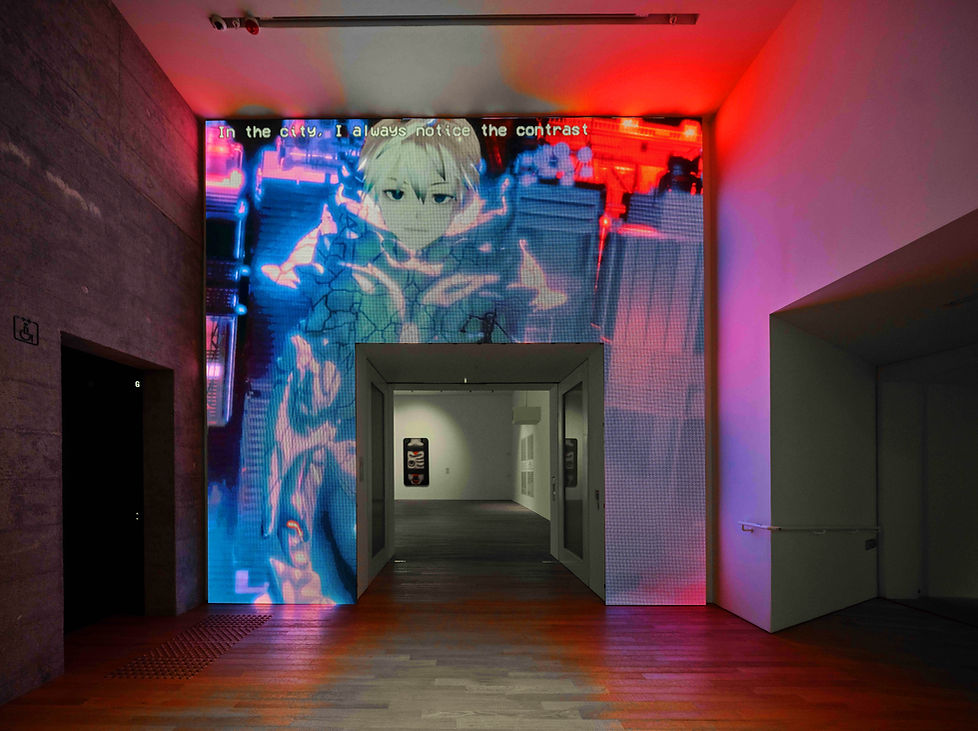

Super
Record Cover
NOSTALGIA MACHINES
.jpg)
2019, Nostalgia Machines, 3D Animation, LED Screen, 06:23
In collaboration with Reijiro Aoyama
Since the late 1970’s, cyberpunk and dystopian science-fiction has used the East Asian metropolis as its de-facto model of the future. Retrofitted architectures weathered by monsoonal rain and futuristic technologies pushed beyond the point of exhaustion bathed in the neon glow of skyscrapers have come to delineate the contours of a techno-orientalist urban nightmare. It is the antithesis of the classical western city and yet also deeply seductive because it taps into the images, landscapes and fears of the Asian Other that colonize the collective unconscious of the west. The cyberpunk aesthetic might also be seen as the displaced and sublimated fear of a hyper-industrialized Japan whose newly emergent economic power in the 1980’s was highly visible through the proliferation of cutting edge consumer technology and the penetration of Japanese corporate culture into the economic infrastructures of the west.
In his seminal book ‘Asia as Method’, Kuan-Hsing Chen writes about the sub-empires in Asia, of the secondary dependent imperialisms based on culture and economy rather than military force which the Japanese and Taiwanese have created in Southeast Asia. Koichi Iwabuchi has also extensively documented the propensity for Japanese cultural texts in the 1990’s to use Southeast and East Asia as the exotic location for its stories to perpetuate the hierarchical notion that ‘the present of Asia is the eternal past of Japan.’ In Japanese science-fiction of the era, contemporary Hong Kong in particular becomes the model for apocalyptic visions of the Japanese future in anime feature films like Ghost in the Shell (1995) and Akira (1989) suggesting a ‘sub-techno-orientalism’ where the decaying Hong Kong cityscape becomes the dystopian future of Japan as Japan became the image of the future for the west. As science-fiction writers in the west created the cyberpunk city to articulate its crisis of identity in response to the economic rise of Japan, the Japanese created their own sub-techno-orientalism in their science-fiction in response to the competing Asian modernities coming from the South East Asian Tiger economies like Hong Kong, Singapore, Thailand, South Korea and Taiwan which challenged Japan’s post-war position as the hegemonic Asian economic power in the face of its own economic crisis.
The work ‘Nostalgia Machines: 2050’ by Zheng Mahler is a dramatization of this thesis, which actualizes the notion of the ‘anime machine’ as a cultural technology that paradoxically reasserts geo-political and cultural hierarchies in Asia through futurist modes of nostalgia as an imperialist response to the economic rise of Southeast and East Asia in the era of globalization. Zheng Mahler take one step backward to take a giant leap forward into the speculative future to address the contemporary crises as well as crises yet to come. The work looks at the rise of China as the competing economic superpower against the west as well as Japan, the ontological threat of Hong Kong to the mainland (as the capitalist state of exception which allows it to exist) and the obvious threat of the mainland to the autonomy of Hong Kong. ‘Nostalgia Machines: 2050’ appropriates parallel registers of retro-futurist aesthetics, from cyber punk to 1990’s anime, to provide a critical and satirical allegory for the processes of geo-political and economic cat-and-mouse and how they are sublimated through the speculative cultural imaginary.
The city is erotic and dreary.
Information floods the streets and alleyways like water.
Not long ago this was science-fiction, but once you imagine a technology, constructing it becomes simple.
The nostalgia machine simulates historical fiction for those who choose not to live in the present.
But new technologies require outlaw zones, terrains in which vibrant new signifying surfaces layer over the detritus of obsolescent forms.
Radicals acquired black market variations of the nostalgia machine, splintering into competing factions and ideologies, between strange, maritime nihilists who program the machine to reproduce the Great Clearance of the South China Coast and arch hedonists who project the 15 days of stateless chaos between the surrender of the Japanese empire and the return of the British.
Every night, I watch the past unfold in the present.
In the city, I always notice the contrast between the skyscrapers and the old streets below. My feeling is that these two, originally very different, are now in a situation where one invades the other.
Maybe it's a tension brought about by the nostalgia machine. A situation in which two entities are kept in a strange neighbouring relationship. Perhaps this is what the future is.
The machine reproduces the pleasures of viewing the present through the past. We indulge in nostalgia at the expense of history, since the layers of recycled materials, objects and stories are neither past nor future but a collective hallucination of the present.
My being is lifted high above the ground and sheltered from the destructive power of the machine. I dream and construct an identity while perched on the rooftop, trying to recreate memories which never existed.
Why did Hong Kong become an inspiration for a city of the future?
Perhaps because the colonial city was the model for what the contemporary globalized city became. It was the first act in the theatre of encounter between industrial capitalism and the other.
The nostalgia machine simulates a memory of what the city was by buying into a failed model of the present and reversing its terms and values.
The imaginary city the nostalgia machine projects is on the edge of time and space, floating between western empires and asian sub-empires.
Once, the present of Asia was our eternal past. Then it became a vision of our dystopian future.




_JPG.jpg)